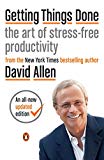
For more than 20 years, David Allen has been a management consultant and executive coach. Allen’s first book Getting Things Done: The Art of Stress-Free Productivity, published in 2001, became a National Bestseller. Allen has been called a personal productivity guru whose work has been featured in Fast Company, Fortune, the Los Angeles Times, The New York Times, The Wall Street Journal, andother publications.
Getting Things Done is divided into three parts. Part 1 provides an outline for getting control of your life through the five stages of mastering workflow: collection, processing, organizing, reviewing and doing. Part 2, which is well over half the book, repeats a lot of what is said in Part 1, but provides much more detail on the application of Allen’s methodology. Part 3 explains why Allen’s methods work and the benefits to be gained from using his approach.
The entire process, including inputs, processing/thinking, and outputs (actions and action lists), is conveniently summarized in a flowchart provided in the book. Allen’s philosophy is that to be one’s most productive self, one must be able to think clearly. In order to think clearly, one must have completely downloaded from one’s short-term memory or RAM (like computer RAM) all the "open loops" -- unfulfilled commitments one has made to oneself. This freesthe mind to do naturally what it does best -- think about things rather than of things. Allen gives pointers for using one’s critical thinking skills, including three methods for making decisions about what actions to take, in Chapter 9.
Once one has everything off his mind and written down, in paper or electronically, one has to decide, "What’s the next action?" This is THE critical question. Once this is decided, the action must be completed or tracked in a trusted system, such as a Personal Digital Assistant (PDA).
Allen also has a two-minute rule, which states that as one goes through their in-box and determines next actions, any next action that can be completed in two minutes or less should be completed immediately. In this way, a lot of items are touched only once and are forever cleared from "psychic RAM."
Allen outlines a process for getting RAM cleared in the first place and then for keeping it clear on a daily basis, as new things come into one’s "in" box. The "What’s the next action?" question must be asked on the front-end, when the item from the "in" box is first reviewed.
Applying Allen’s system is put forth as a way for today’s knowledge worker to have a competitive edge in the new millennium. His system is as applicable to one’s home environment and projects as it is to one’s work. He also claims it can help procrastinators.
Getting Things Done is part tools and techniques, part psychology. Allen says that mastering your time enables you to live in the present moment. This may be the true gift of this book.
Already have an account? Log In Now